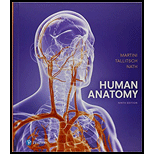
Human Anatomy (9th Edition)
9th Edition
ISBN: 9780134320762
Author: Frederic H. Martini, Robert B. Tallitsch, Judi L. Nath
Publisher: PEARSON
expand_more
expand_more
format_list_bulleted
Question
Chapter 20, Problem 1CT
Summary Introduction
To analyze:
The reason that athletes often move to elevations higher than those, at which they will compete, several months before a competition.
Introduction:
Red blood cells (RBCs) play an important role in the body of an organism. They carry oxygen from lungs to different tissues. RBC is produced in red bone marrow and each has a lifespan of 120 days. The level of hemoglobin or number of RBCs determines the oxygen transport to the tissues. Hemoglobin is a globular protein, which contains two alpha chains, two beta chains, and a nonprotein pigment called heme. There are four heme units in one hemoglobin molecule and each heme unit can hold an iron, which binds to an oxygen molecule.
Expert Solution & Answer
Want to see the full answer?
Check out a sample textbook solution
Students have asked these similar questions
b) Write a note on physiological responses to exercise in heat and cold?
Why were the finishing times of endurance events rather slow at the 1968 Olympics, held in 2,200-meter-high Mexico City?
Deliberately shifting equilibrium in the body provides some advantages. Explain why some athletes train at high altitudes.
Chapter 20 Solutions
Human Anatomy (9th Edition)
Ch. 20 - The five figures to the right are labeled a...Ch. 20 - Prob. 2RFTCh. 20 - Prob. 3RFTCh. 20 - The most abundant proteins in blood are (a)...Ch. 20 - 5. The major classes of white blood cells...Ch. 20 - Prob. 6RFTCh. 20 - Prob. 7RFTCh. 20 - Prob. 8RFTCh. 20 - Prob. 9RFTCh. 20 - Prob. 10RFT
Ch. 20 - 11. Platelets are
(a) large cells that lack a...Ch. 20 - Prob. 1RCCh. 20 - Prob. 2RCCh. 20 - Prob. 3RCCh. 20 - Prob. 4RCCh. 20 - Prob. 5RCCh. 20 - What is the fate of megakaryocytes?Ch. 20 - Prob. 7RCCh. 20 - Prob. 8RCCh. 20 - Prob. 1CTCh. 20 - 2. Mononucleosis is a disease that can cause an...
Knowledge Booster
Similar questions
- Which activity would be more likely to create an oxygen debt in an individual who regularly exercises: swimming laps or lifting weights?arrow_forwardHow might the anatomy and physiology of persons who were born and raised at very high altitudes be different from those who were born and raised in the lowlands and have only recently become acclimated to high elevations?arrow_forwardExplain why weight lifters are not well adapted for distance running.arrow_forward
- Why would an increase in heart rate, breathing rate and usually an increase in perspiration accompany exercise?arrow_forwardA well-conditioned athlete shows fewer changes in his or her circulation and breathing in response to exercise than does someone in poor condition. Why?arrow_forwardWhy is it not possible for a person to sprint for 5 km?arrow_forward
- Which of the following is a benefit of regular strength/resistance training? a) all of the above O b) increase in muscular strength and endurance O c) reduced risk of injuries and cardiovascular diseases O d) improved body composition and weight managementarrow_forwardCan the limitation of training equipment hamper the essential requisites of physical fitness?arrow_forwardWhich one of the following is key element to overall athletic performance? Select one: a. Increase available lactic acid to increase neural sensitivity. O b. Building up inorganic phosphate depos above 10 mM levels to increase muscle contractibility c. To maximize energy use without reaching the limitations of any of the energy supply systems. O d. Minimize tissue hydration in order to maximize osmolality of tissue.arrow_forward
arrow_back_ios
SEE MORE QUESTIONS
arrow_forward_ios
Recommended textbooks for you
 Principles Of Radiographic Imaging: An Art And A ...Health & NutritionISBN:9781337711067Author:Richard R. Carlton, Arlene M. Adler, Vesna BalacPublisher:Cengage Learning
Principles Of Radiographic Imaging: An Art And A ...Health & NutritionISBN:9781337711067Author:Richard R. Carlton, Arlene M. Adler, Vesna BalacPublisher:Cengage Learning

Principles Of Radiographic Imaging: An Art And A ...
Health & Nutrition
ISBN:9781337711067
Author:Richard R. Carlton, Arlene M. Adler, Vesna Balac
Publisher:Cengage Learning